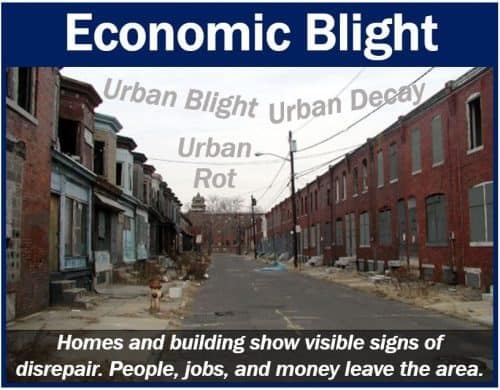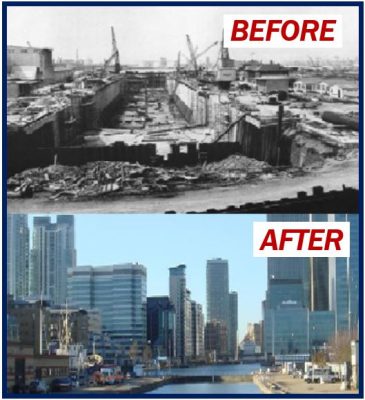What is economic blight? Definition and examples
Economic blight occurs when a part of town goes downhill. In other words, when it shows visible signs of deterioration, dereliction, disrepair, age, and crime. Economic blight refers to the visual evidence of a declining economy, which typically affects city hubs and the high street of towns. We also use the terms urban blight, urban decay, urban rot, or simply blight with the same meaning.
When urban blight occurs, businesses and residents leave an area due to a combination of economic downturns. In other words, wealth – jobs, property tax money, and demand for goods and services – leaves. Often, average household incomes also decline.
BusinessDictionary.com has the following meaning of economic blight:
“The bad effects of a destructive economic status on city hubs and main street towns. In recent times, investors have banded together to try to revitalize communities that have been hit hard by economic difficulties.”

What ‘economic blight’ means for most people
When we hear the term, we typically think of:
– Buildings in a state of disrepair, i.e., derelict buildings.
– Infrastructure either abandoned or in a state of disrepair.
– An exodus of people, jobs, and money.
– An abundance of graffiti.
– A high crime rate.
– Lots of street gangs and drug trafficking.
– A desolate cityscape (city landscape).

Economic blight – inner-city decay
For many of us, thinking about the ‘bad part of town‘ is to think about economic blight. An area that has suffered urban blight has many vacant properties, which may also be boarded up. Many windows are either broken or have no glass.
When an area suffers from economic blight, the crime rate is relatively high.
Many city and town centers experienced inner-city decay during the last quarter of the twentieth century.
Most downtown areas had previously been bustling with offices, shops, banks, post offices, etc.
During the second half of the twentieth century, out-of-town shopping malls mushroomed. Movie theaters, bank branches, stores, and other businesses moved into these malls.
Shops, etc., also closed down in large numbers in city and town centers. Hence, inner-city decay set in. Economic blight struck the inner cities.

